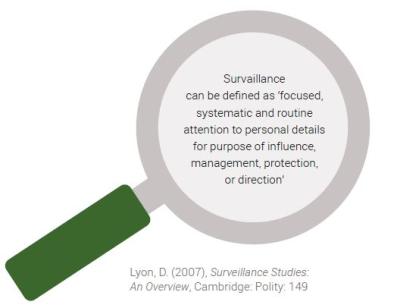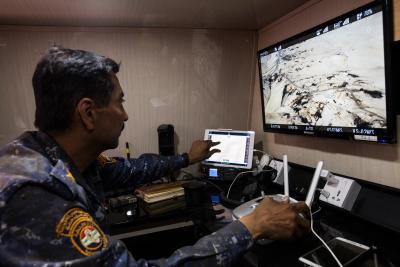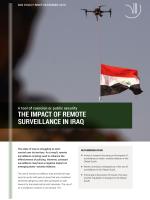The impact of remote surveillance in Iraq
The state of Iraq is struggling to exert control over its territory. As a result, remote surveillance is being used to enhance the effectiveness of policing. However, constant surveillance may have a negative impact on emerging state–society relations.
■ Work to introduce transparency in the use of surveillance in the Global South.
■ Encourage a discussion of issues of privacy and the regulation of airspace in the Global South.
The use of remote surveillance may provide the Iraqi security sector with eyes in areas that are considered inherently dangerous and often portrayed as safe havens for transnational terrorist networks. The use of air surveillance, however, is not neutral. Thesystematic observation of behavior with the intention of controlling the observed will inevitably affect how citizens relate to the state and to each other.
Surveillance to preempt threats
Islamic State remains active across Iraq, particularly in rural parts of Kirkuk, Salah al-Din, Diyala and Anbar. The Iraqi security forces and their Western allies are using surveillance to enhance security by detecting attempts at infiltration, military movements or other suspicious activities. Drones make it possible to track the movement of suspects across large areas.
Surveillance is about risk management. The core idea is that the more data is collected, the more effectively it can be used not only to deter and investigate crimes, but also to preempt threats. The downside is that everybody on the ground is treated as a potential risk until proved otherwise. This blurs the difference between civilians and combatants. The problem is underscored by an expansion of the kinds of data that are collected and considered a matter of security.
Particularly in states such as Iraq, where threats are combined with a lack of accurate information, surveillance is presented as a shortcut that allows the surveillance operative to see the “truth” of who is a legitimate target and consequently divide Iraqis neatly into friends and foes. Remote surveillance has the added benefit of allowing the person at the monitor to observe events from a

The imprisoning gaze
Surveillance is not simply a matter of reconnaissance of an opponent but includes the intention to contain or affect his or her behavior. As such it has a long history, but new technology has increased capacity and introduced the doctrine of constant surveillance. Much more data is collected, generating large databases that are used to construct profiles of individuals or patterns of suspicious behavior. The idea is to spot threats and preempt attacks.
The effects on individuals of living under constant surveillance has been described with reference to Bentham’s image of the Panopticon, a type of prison with a central tower that is able to observe everything that goes on in all prison cells constantly without the prisoners being aware of when they are being observed. The result is often said to be a system of self-policing, as the prisoners will have the impression that all their movements are being monitored andreported. Hence, whereas proponents of increased surveillance herald it as a means of increasing direct targeting and the surgical removal of ‘bad guys’ while efficiently minimizing collateral damage, others stress that the perception of being under constant surveillance has psychological effects on the general population. Extensive surveillance has been shown to alter and disrupt the political and social lives of communities, for instance, by indirectly encouraging people to avoid social and political gatherings.

Who is looking?
In the Global North, surveillance is widely understood as a tool used by the state to care for, control and ultimately protect its citizens. As the use of surveillance becomes more pervasive, the debate focuses on striking a balance between state surveillance and the individual’s right to privacy. xIn Iraq, however, the state has a history of using extensive surveillance as a means of coercion. Under the rule of Saddam Hussein surveillance was carried out by spies, still a key component of intelligencegathering in Iraq. Now, however, it is complemented by an increased focus on remote surveillance. Thefirst extensive use of airspace to enhance security in Iraq was the British use of the RAF to control rebellious tribes and villages in the 1920s. America’s justifications for its use of drones and air surveillance in Iraq build on the former British colonial rhetoric, sometimes explicitly. This history affects how those being observed perceive surveillance, just as social and political norms shape who is being singled out for surveillance. Consequently, minorities and marginalized groups risk being targeted excessively, leaving them feeling excluded and ultimately treated as second-rate citizens.
The Iraqi security forces are developing their surveillance capacity in part through transfers of sophisticated surveillance technologies and aerial reconnaissance capabilities from the Global North, as well as from China, Russia and Iran, but so are other internal actors, including Islamic State. Moreover, Iran, Italy, Russia, Syria, Turkey, the U.K., and the U.S.—are believed to be operating drones in Iraq. Consequently, people on the ground will not know who is watching them. Iraqi officials have previously condemned America’s use of unarmed aircraft in Iraqi airspace asan affront to their state. Surely the mere presence of non-Iraqi aircraft, or even the perception of their presence, underscores an image of the Iraqi state as unable to exercise domestic control and maintain its territorial integrity. The notion of a “sovereign ceiling” has been used to introduce a vertical aspect into discussions of state sovereignty and national airspace. In the Iraqi case, the no fly zone in northern Iraq imposed from 1991 to 2003 is the clearest example of how Iraqi sovereignty is also limited vertically. There is a need to understand how external incursions into the Iraqi state’s airspace affect Iraqi citizens’ perceptions of their state’s claim to be sovereign and to have a monopoly of violence.
People on the ground will not know who is watching them.
Remote policing
The Iraqi security forces continue to struggle to uphold a monopoly of violence in a context where militias, some of which are formally part of the security forces, continue to act autonomously with impunity and where Islamic State remains a threat to local communities. There is a substantial lack of trust between communities and law enforcement agencies, coupled with the continued militarization of the police force. External donors, including Denmark, prioritize support to the capacity-building of the police forceand transforming it into a more service-oriented organization. One specific focus area is support for community policing to create safe environments where the security concerns of local communities can be taken seriously and professionally investigated. Growing surveillance capacity can serve as a tool tocreate a more effective security state, but it can also limit the space for dissent and critical debate, as well as disproportionately affecting marginalized minorities. In the Iraqi context, the application of wide-area surveillance may counteract the effort to rebuild trust between communities and law enforcement agencies by estranging marginalized groups such as the Sunnis, who already feel targeted by unjust anti terrorism laws. Remote surveillance assumes guilt until innocence is established, which may exacerbate local grievances related to the slow pace of reconstruction in post-IS areas. Altogether this aggravates feelings of being treated as second-class citizens. Thus, in the Iraqi context, while surveillance may provide valuable intelligence, it may at the same time jeopardize ongoing efforts to restore trust and build sustainable relationships between state and society.
Maria-Louise Clausen, researcher at DIIS (mlcl@diis.dk)
DIIS Experts


